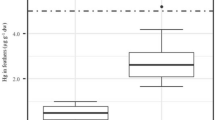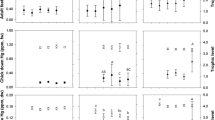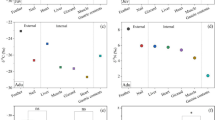Abstract
Seabirds are used frequently as indicators of mercury contamination in marine ecosystems, but few studies have examined the forms of mercury found in seabird tissues. Here we compare concentrations of total and organic mercury in feathers (n = 5) of six sympatric nesting seabirds and in egg components of Leach’s storm-petrels from Machias Seal Island, New Brunswick, Canada, during the 2006 breeding season. Essentially all (82–133%) mercury found in seabird feathers and egg components was methyl mercury, with no interspecific differences in percentage methyl mercury. This pattern is consistent with the hypothesis that feather-molt and egg production eliminate toxic methyl mercury, while inorganic forms from demethylation in the liver remain in internal tissues. Additional studies across more species, and comparisons with percentage methyl mercury in internal tissues, are required to validate this theory.


Similar content being viewed by others
References
Agusa T, Matsumoto T, Ikemoto T, Anan Y, Kubota R, Yasunaga G, Kunito T, Tanabe S, Ogi H, Shibata Y (2005) Body distribution of trace elements in black-tailed gulls from Rishiri Island, Japan: age-dependent accumulation and transfer to feathers and eggs. Environ Toxicol Chem 24:2107–2120
Appelquist H, Asbirk S, Drabæk I (1984) Mercury monitoring: mercury stability in bird feathers. Mar Pollut Bull 15:22–24
Bond AL (2007) Patterns of mercury burden in the seabird community of Machias Seal Island, New Brunswick. M.Sc., University of New Brunswick
Braune BM, Gaskin DE (1987) A mercury budget for the Bonaparte’s gull during autumn moult. Ornis Scand 18:244–250
Burger J (1993) Metals in avian feathers: bioindicators of environmental pollution. Rev Environ Toxicol 5:203–311
Burger J, Gochfeld M (1997) Risk, mercury levels, and birds: relating adverse laboratory effects to field biomonitoring. Environ Res 75:160–172
Burger J, Gochfeld M (2000) Metal levels in feathers of 12 species of seabirds from Midway Atoll in the northern Pacific Ocean. Sci Total Environ 257:37–52
Burger J, Gochfeld M (2002) Effects of chemicals and pollution on seabirds. In: Schreiber EA, Burger J (eds) Biology of marine birds. CRC Press, New York, pp 485–525
Burger J, Gochfeld M (2004) Metal levels in eggs of common terns (Sterna hirundo) in New Jersey: temporal trends from 1971 to 2002. Environ Res 94:336–343
Cook RD (1977) Detection of influential observation in linear regression. Technometrics 19:15–19
Cook RD (1979) Influential observations in linear regression. J Am Stat Assoc 74:169–174
Day RW, Quinn GP (1989) Comparisons of treatments after an analysis of variance in ecology. Ecol Monogr 59:433–463
Evers DC, Clair TA (2005) Mercury in northeastern North America: a synthesis of existing databases. Ecotoxicology 14:7–14
Fimreite N, Karstad L (1971) Effect of dietary methylmercury on red-tailed hawks. J Wildl Manage 35:293–300
Furness RW, Camphuysen K (1997) Seabirds as monitors of the marine environment. ICES J Mar Sci 54:726–737
Games PA, Howell JF (1976) Pairwise multiple comparison procedures with unequal n’s and/or variances: a Monte Carlo study. J Educ Stat 1:113–125
Goodale MW, Evers DC, Meirzykowski SE, Bond AL, Burgess NM, Otorowski CI, Welch LJ, Hall CS, Ellis JC, Allen RB, Diamond AW, Kress SW, Taylor R (2008) Marine foraging birds as bioindicators of mercury in the Gulf of Maine. EcoHealth (in review)
Kim EY, Murakami T, Saeki K, Tatsukawa R (1996) Mercury levels and its chemical form in tissues and organs of seabirds. Arch Environ Contam Toxicol 30:259–266
Kim EY, Goto R, Tanabe S, Tanaka H, Tatsukawa R (1998) Distribution of 14 elements in tissues and organs of oceanic seabirds. Arch Environ Contam Toxicol 35:638–645
Magat W, Sell JL (1979) Distribution of mercury and selenium in egg components and egg-white proteins. Proc Soc Exp Biol Med 161:458–463
Martins I, Costa V, Portiero FM, Santos RS (2006) Temporal and spatial changes in mercury concentrations in the North Atlantic as indicated by museum specimens of glacier lanternfish Benthosema glaciale (Pisces: Myctophidae). Environ Toxicol 21:528–532
Mason RP, Sheu G-R (2002) Role of the ocean in the global mercury cycle. Global Biogeochem Cycles 16:1–14
Monteiro LR, Furness RW (1995) Seabirds as monitors of mercury in the marine environment. Water Air Soil Pollut 80:851–870
Monteiro LR, Furness RW (2001) Kinetics, dose-response, and excretion of methylmercury in free-living adult Cory’s shearwaters. Environ Sci Technol 35:739–746
Nriagu JO (1989) A global assessment of natural sources of atmospheric trace metals. Nature 338:47–49
Nriagu JO, Pacyna JM (1988) Quantitative assessment of worldwide contamination of air, water and soils by trace metals. Nature 333:134–139
Spalding MG, Frederick PC, McGill HC, Bouton SN, Richey LJ, Schumacher IM, Blackmore CGM, Harrison J (2000) Histologic, nerologic and immunologic effects of methylmercury in captive Great Egrets. J Wildl Dis 36:423–435
Thompson DR, Furness RW (1989a) Comparison of the levels of total and organic mercury in seabird feathers. Mar Pollut Bull 20:577–579
Thompson DR, Furness RW (1989b) The chemical form of mercury stored in south Atlantic seabirds. Environ Pollut 60:305–317
UNEP (2002) Global mercury assessment. United Nations Environmental Programme—Chemicals, Geneva, Switzerland
Weiner JG, Krabbemhoft DP, Heinz GH, Scheuhammer AM (2003) Ecotoxicology of mercury. In: Hoffman DJ, Rattner BA, Burton GA Jr, Cairns J Jr (eds) Handbook of ecotoxicology. 2nd edn. CRC Press, New York, pp 409–463
Acknowledgments
We thank G. Bouchard, T. Clarke, and M.-P. Godin for assistance in the field, A. Patterson (Bold Coast Charter Co., Cutler, Maine) for providing safe transportation to the island, E. Yumvihoze for performing lab analyses, and T. Jardine and D. Lean for many stimulating conversations on this topic and assistance throughout the process. Comments from J. Lavers, R. Lavoie, D. Lean, and two anonymous reviewers improved the manuscript. This is ACWERN publication number UNB-71.
Author information
Authors and Affiliations
Corresponding author
Rights and permissions
About this article
Cite this article
Bond, A.L., Diamond, A.W. Total and Methyl Mercury Concentrations in Seabird Feathers and Eggs. Arch Environ Contam Toxicol 56, 286–291 (2009). https://doi.org/10.1007/s00244-008-9185-7
Received:
Accepted:
Published:
Issue Date:
DOI: https://doi.org/10.1007/s00244-008-9185-7




